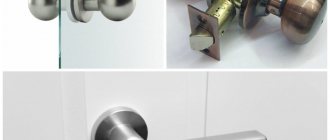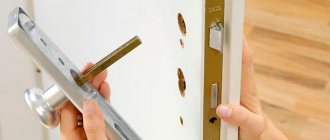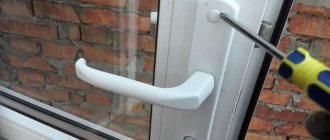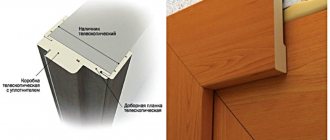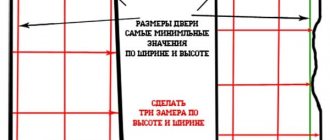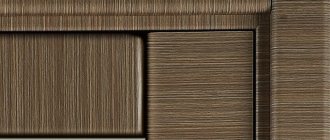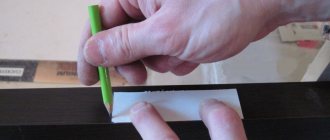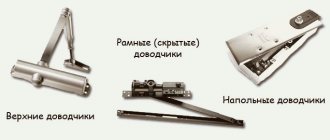A handle is a necessary element of door hardware, designed for convenient opening of doors. The practicality of a door design largely depends on the external aesthetic appearance, design features and functionality of this accessory. With constant use of the door, the handle, regardless of the material and type, often becomes unusable: it wears out and breaks. Therefore, in case of any problems, it must be repaired or replaced with another one. In order not to call a specialist, you can perform this procedure yourself.
Brief instructions on how to disassemble a door handle will familiarize the reader with this simple process.
Design features
Stationary handles are produced without latches or locks. The fastening elements to the door block are screws or self-tapping screws. Such fixed structures are decorative in nature and serve solely for the movement of the door. They can be 1-sided or 2-sided of different shapes, connected by an axial element. They are installed on interior or plastic balcony door blocks, rarely on entrance ones.
Pressure products are 2 L-shaped levers, which are connected by a rod passing through the door block. In such a device, when turning, the halyard tongue enters the inside of the door and locks it. Using the elements, external and interior doors are mounted.
The main advantage of the model is its reliability. The failure rate of push mechanisms is much lower than others.
The rotary mechanism is most often made in the form of a ball or button with a diameter of 50-60 mm with a lock located in the center of the round handle. The keyhole can have a 2-way exit or 1-way with a latch. The door opens with a simple twist. Such fittings may also contain a door opening blocker. Therefore, they are often used in door structures of bathrooms and interior units, and are also called knob handles.
They are compact, easy to install, and low in price, but have disadvantages such as low strength and fragility due to jamming of spare parts inside the mechanism.
Rotary and push products differ in the shape and method of opening the latch.
Components of the mechanism
Pivot and push door products for interior doors have the following spare parts and components:
- pen;
- latch;
- strip or socket;
- decorative flange;
- fasteners;
- special key for squeezing and removing the mechanism.
The door hardware kit with keyhole is supplied with keys.
Common causes of breakage and repair of locks on interior doors
In addition to contamination and drying of the lubricant, which lead to increased wear of the metal parts of the locking mechanism, the locks may also have other malfunctions.
For example, an electromagnetic lock may fail for the following reasons:
- short circuit in the circuit;
- button sticking;
- lack of supply voltage;
- reader failure;
- Damage to the electromagnet or control unit.
Problems can occur in the lock cylinder when there are:
- abrasion of the rotary cam (if the manufacturer saved money and did not use hardened steel);
- wear on the side or top pins;
- wear of the steering cam axis;
- foreign objects getting into the pin mechanism.
The lock of doors between rooms may require repair if the operating springs are weakened, wear appears on the plates, or decorative elements are damaged.
How to remove
Dismantling door hardware is not a problem if you have the necessary tools and minimal theoretical knowledge of the mechanism. You can remove the door handle of an interior door yourself without calling a technician. To do this, you must follow the instructions:
- Support and secure the door.
- Pry the decorative flange with a knife and pull it out a little. Underneath there are fasteners that need to be unscrewed.
- There is a spring-loaded locking pin on the decorative flange of the pressure device. Press it in with a screwdriver. In rotary models, the pin is located inside the body. In order to get to it, insert a key or awl through the technological flange hole. If the pin cannot be felt, rotate the flange until it contacts it.
- Press the pin while pulling the door device.
- Unscrew the mounting screws.
- Separate the inside of the door element from the outside, remove the handle and decorative flange.
- If you need to remove the latch and replace it or repair it, unscrew the screws securing it to the side of the door block, remove the bar, then the mechanism.
When installing accessories to another location, you should not disassemble them for spare parts. It is attached to the door structure in the reverse order. If the handle or latch needs to be repaired or replaced, further disassembly is performed.
Is it possible to repair the door leaf latch mechanism with your own hands?
What could be the reason for failures in such seemingly smooth work? The most common causes of problems are the following:
- Clogged keyhole (the pampering of neighbor's children by putting chewing gum or paper into the keyhole sooner or later leads to breakdown of the internal mechanism).
- Turning the key (in which the mechanism for opening the latch itself does not work).
- The owner is too lazy to take care of the locking mechanism (locks in an apartment need to be lubricated at least once a year, and in a private house - at least 3 times a year).
- The lock does not match the door lock, it is skewed.
- Loose eyelets.
- Jamming of the code part of the mechanism.
How to disassemble a door handle
Replacing a door handle is carried out for the purpose of repairing it due to breakage, wear, in the presence of abrasions, scratches, to improve the appearance, as well as when completely replacing the door block.
Before starting work, the type of mechanism and its features are established, because Some models with a simple device are easy to disassemble, while some have more complex elements, such as latches with locks. Carrying out such work is difficult. Therefore, it is necessary to consider replacing each type of door hardware separately.
Round
To disassemble a round door handle or knob handle, you must follow these recommendations:
- Using a tool at hand, hook up a decorative flange or trim with a simple keyless rotary lock.
- Use an awl, nail or special key to press the opened stopper.
- At the same time, carefully pull out the handle and remove it.
- From the side of the removed part, unscrew the bolts from the mounting plate and disconnect it from the door leaf.
- Unfasten the cylindrical mechanism, the latch.
- Remove the screws and detach the tab.
If there is no need to change, it is rearranged. It happens like this:
- Insert the latch so that the beveled part of the tongue faces the direction the door closes.
- Fasten with 2 screws.
- Insert the piece of hardware with the key drum on the other side of the door structure.
- Attach the clamping part and secure with 2 screws.
- The handle should turn without jamming and return freely to its normal state.
- Correct it. To do this, you need to carefully hold one side and align the other.
- Attach the decorative trim.
- Insert the rest of the handle.
The accuracy of installation and operation is checked both from the latch itself and from the drum device with the key.
Stationary
The stationary product has a simple design and is attached to the door with screws. Therefore, it rarely breaks, and is removed only when it is necessary to exchange it for a more functional model.
To unscrew the fittings for an interior door, you need to do the following:
- Inspect the door mechanism for the presence of an axle rod. To do this, hold the handle with one hand and turn it with the other.
- If the mechanism is located on a rod, remove one supporting side, the second comes off on its own.
- If the rod is not found in the handle, use a flathead screwdriver to remove the screws holding the handle in place.
- Remove it by gently pulling it towards you.
When unscrewing the mechanism, you must carefully hold it with your hand so that after removing the connecting screws, part of the product does not fall out of the connector and is damaged.
For interior doors
In the pressing device, the process of disassembling it causes difficulties. This is due to the fact that the fittings are attached to the axial rod and tightened with a 4-sided joint.
To repair the handle of an interior door, disassembling the push mechanism is carried out in 3 stages:
- Remove the screws that hold the cover in place and remove the plugs.
- Then you need to loosen the fixation of the rod and separate the 4-sided square.
- Remove the cover plate on the other side, the remaining part of the mechanism and the axial rod. After removing the parts, you need to pull the handle towards you.
The pressure product is ready for replacement or repair.
Expert advice
Almost all experts, when removing and disassembling interior door locks, note several points that need to be paid special attention to.
- You can remove the spring manually or pry it off with a screwdriver, covering the mechanism with a rag or hand.
- It is important to wipe all parts of the mechanism with a dry, clean rag to remove old grease and assess the degree of wear, as well as the possibility of further use or the need for replacement.
- Before assembly, it is very important to lubricate all parts of the lock mechanism, including the spring, with special lubricant. This procedure contributes to longer, trouble-free operation of the product.
- Lubricant must be selected from a range of graphite options. Graphite-based substances are less susceptible to temperature changes, dust accumulation, etc.
In this article we examined the features of removing and disassembling interior door locks. However, before disassembling such products yourself, it is very important to read the relevant information in various sources and get advice from a professional technician.
Sources:
- https://furni-info.ru/kak-snyat-dvernuyu-ruchku.html
- https://m-strana.ru/articles/kak-razobrat-dvernuyu-ruchku/
- https://ODveryah.ru/furnitura/kak-razobrat-dvernuyu-ruchku
- https://o-dveryah.ru/zamki/kak-snyat-dvernuyu-ruchku-mezhkomnatnoy/
- https://okcomfort.com/dveri/zamena-mezhkomnatnoj-ruchki.html
- https://DomNaMne.ru/zabory/zamki/kak-pravilno-razobrat-zamok-mezhkomnatnoj-dveri
- https://stroy-podskazka.ru/dveri/zamki/mezhkomnatnye/kak-snyat-i-razobrat/
- 1
How to fix a pen
Door handle repairs are often carried out in the following cases:
- the mechanism does not return to its original position;
- the handle jams and is difficult to turn;
- The tongue does not move when turning or pressing the device;
- the handle falls out without damaging the base.
Often the cause of these problems is wear and tear of the part during constant use. Therefore, it is periodically necessary to lubricate the mechanism parts and the keyhole, and clean them from dust and dirt. When lubricating, the door product is rotated so that the viscous liquid is evenly distributed among the elements.
If the handle is loose, it is necessary to correct and tighten the fasteners.
Sometimes it is necessary to repair the fittings in a metal Chinese door. Products made in China from silumin malfunction and break, and installing a lock on such a door is not easy. It's easier to replace the mechanism. The principle of operation is similar to replacing an element in interior doors.
In the interior
In door handles for interior doors, repairs are most often made when the handle falls off. The base remains attached.
The reason is the use of low-quality fittings, as a result of which the locking ring could break or fall off.
To carry out repair work, perform the following steps:
- Unfasten the base from the door.
- Inspect the retaining ring. If it has moved, you need to adjust its position and install it. If the ring bursts or breaks, it is replaced with further installation of the handle.
The duration of the procedure is 15-20 minutes.
Repair of the door handle of an interior door is carried out if, after opening the doors, the fittings do not return to their normal position.
The cause of the malfunction is a broken or displaced spiral.
To replace the spiral, carry out the following work:
- remove the device;
- unfasten the damaged part and replace it;
- secure with a locking ring at the top;
- install the mechanism.
If the spring breaks, you can make it yourself from a small piece of steel wire. Pre-wind it, heat it over the fire until it turns bright red and put it in cold water.
Caring for fittings
Replacing the handle is a simple process. However, proper care of the fittings will guarantee durability and uninterrupted functionality. Intensive use causes locking mechanisms to become unusable. They wear out, get old, don’t turn, don’t latch. Care instructions:
- Cleaning . Wipe the mechanisms from dust in a timely manner with special cleaning agents. It is not recommended to use substances that contain aggressive acids, alkalis and abrasive particles. Door hardware suffers from such components and quickly rusts. After cleaning, wipe it with a dry, clean cloth.
- Checking mechanisms . If the user feels that the handle is loose, then it needs to be tightened. Inattention and negligent attitude will lead to the final failure of all mechanisms present in the design.
- Additional door care . In damp rooms it is susceptible to damage by mold and mildew. Wooden panels are eaten by insects. Moisture-proof compounds are used. When the panel swells, the door lock rusts and is squeezed out. The result is that the structure does not close, the handle spoils the slopes and walls.
- Careful handling . Careful, careful use of the handle does not cause mechanical damage to it. Jerking or forcefully slamming the door will damage the design and functionality.
- Lubrication, inspection for cracks. If the handle sticks when turning, it is necessary to lubricate the mechanisms with special oil. The composition is sold in construction stores. Over time, the panel near the locking element cracks and gradually forms gaps. Typically, such consequences appear when the handle is inserted carelessly.
Solve the problem in several ways:
- Seal small cracks with silicone sealant and putty so that the new layer does not protrude beyond the panel. Otherwise the door will not close. Wait until completely dry and sand the surface. Choose the color of the putty mixture to match the tone of the door surface.
For large gaps, use wood chips made of the same material as the doors. Select wood chips with identical gap dimensions. Carefully insert, cover with sealant, then putty. You can fix the element with construction glue. The main thing is that it does not protrude beyond the boundaries of the piece. After drying, check the door to ensure it can close completely.
Attention. Some models have hard-to-reach elements. It is not always possible to properly disassemble the mechanism in order to lubricate all its parts. You can make the process easier if you use a convenient attachment in the form of a thin and long tube or brush with natural fibers.
Conclusions and useful video on the topic
Video instructions for installing the latch:
In our article, we reviewed detailed instructions for installing a latch handle on an interior door. With its help, you can do it yourself without any problems. The task is simple even for people without special skills and practice.
Do you have any questions about installing the latch? Or would you like to share your personal experience of installing a latch handle? Write your recommendations, ask questions to our experts, add a photo of the finished work - the feedback block is located below.
